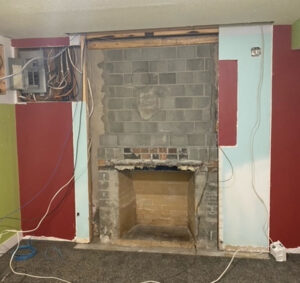Q: What’s the best way to air seal and insulate between a masonry fireplace and the surrounding wall? There is a lot of contradictory advise around about how to handle this. I will be installing a direct-vent gas insert with aluminum liners in my fireplace opening, so heat in the flue cavity will not be a big concern.

The chimney material is cement block above the rough-in opening (see photo) I was hoping to reframe and seal/insulate the wall above and to the sides of the fireplace opening but would not be able to use foam board against the chimney due to the 2” clearance rule to combustibles. How would I prevent moisture and air migration from the outside in that area? I plan on using rockwool in the wall cavity that will be spaced 2” off the masonry. — Dan K.
A: Sealing between a masonry chimney and wood framing is tricky. Codes generally call for a 2-inch gap that is not filled with any insulation – even a non-combustible material such as mineral wool.
The gap is required to prevent heat transfer to the framing. If there is ever a hot spot in the masonry, the gap is there to provide a physical break. The regulations are the same whether you burn logs in a fireplace or gas in an insert.
Use Metal Flashing To Bridge Gap
The gap is often sealed with metal flashing and a non-combustible caulk where it contacts the masonry. To bridge from the chimney to a drywall surface, you can patch in with cement board (such as tile backer) for the last 6 inches or so and caulk the cement board to the chimney with fireproof sealant. You can then finish the cement board-to-drywall joint with standard joint compound or skim-coat plaster.
There are a wide variety of caulks and sealants used in fire blocking, but not all are completely non-combustible. I would look for a non-combustible fireblock sealant approved for contact with chimneys, such as 3M Fireblock Sealant FB136. If in doubt, check with your local building inspector as local codes and code interpretations have the final say.
Seal The Vertical Chase
One other thing to consider is the vertical chase around the chimney — in this case, a 2 inch gap, but sometimes much larger with manufactured fireplaces. It’s good to seal this chase where it enters the attic to reduce air and moisture leakage into the attic. Use metal flashing and fireproof sealant, as described. In this case, the flashing is horizontal between the ceiling joists and the chimney.

To seal other air leaks into the attic, canned foam is usually a good choice. It can be used in combination with pieces of foil-faced foam for larger gaps or to build airtight boxes if needed. Common leakage paths are shown above.
Air leaks into the attic are a major source of air infiltration into a house. All the air that leaks out the top of the house is replaced by air leaking in lower in the structure. In cold climates, air leakage into the attic also contributes to ice dams and condensation on the roof sheathing. — Steve Bliss, BuildingAdvisor.com
Leave a Reply